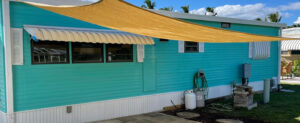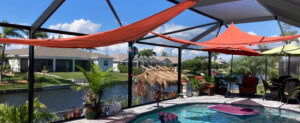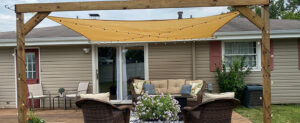Contact Us: [email protected] WhatsApp: +86-1365-3417-367
Introduction
A day at the beach is synonymous with sun, sand, and surf. However, the joy of basking in the sun’s warmth comes with the risk of UV exposure. Beach shade sails not only offer a reprieve from the sun but also add a touch of elegance to the beachside ambiance. The perfect blend of functionality and design, these sails provide essential UV protection while facilitating a cool, shaded area to relax and enjoy the outdoors.
Choosing the Right Beach Shade Sail
Selecting the ideal beach shade sail involves considering various factors, including the type of sail, size, and the specific needs of your outdoor space. Here’s a breakdown to help you make an informed decision.
Types of Beach Shade Sails
Beach shade sails come in different shapes and sizes, each offering unique benefits:
- Triangular Shade Sails: Known for their versatility, triangular sails can be installed in various configurations to provide ample shade. They are particularly favored for their ability to offer excellent UV protection while ensuring good airflow, reducing the temperature underneath.
- Square and Rectangular Shade Sails: These are ideal for covering larger areas, providing extensive shade coverage. Their straight edges and angular design can complement the architectural elements of a home or outdoor space.
- Shibumi Shade: This unique type of beach shade is wind-powered, designed for easy setup, and made from materials like ocean-bound recycled plastic bottles. Shibumi Shade stands out for its lightweight design and the capability to shade a large group, making it a popular choice for beach-goers seeking convenience and sustainability.
Taking Accurate Measurements
Choosing the correct size for your beach shade sail is crucial. Here’s a step-by-step guide to ensure you select a sail that fits your space perfectly:
- Identify the Installation Area: Measure the length and width of the area you want to cover. Consider any obstacles that might affect installation, such as trees or posts.
- Determine the Height: Decide how high you want the sail to be installed. This can impact the amount of shade provided throughout the day.
- Orientation for Maximum Shade: Keep in mind the sun’s path to orient the sail for optimal shade coverage.
Common Sizes and Shapes
Understanding the common sizes and shapes available can guide you in selecting a beach shade sail that meets your needs:
- Triangular Sails: Common sizes range from small (3m x 3m x 3m) to large (5m x 5m x 5m), suitable for different space requirements and configurations.
- Square and Rectangular Sails: These sails offer a practical solution for larger spaces, with sizes tailored to cover extensive areas effectively.
Selecting the right beach shade sail involves careful consideration of your space, the sun’s path, and your aesthetic preferences. By understanding the different types, sizes, and installation requirements, you can enhance your outdoor area with a functional and stylish shade solution.
Installation Tips and Tricks
Properly installing a beach shade sail not only ensures maximum efficiency and durability but also enhances the overall appearance of your outdoor space. Here’s how to get it right from the start.
Selecting the Ideal Location
- Consider the Sun’s Path: Understanding the movement of the sun across your space will help you position the sail for optimal shade throughout the day.
- Identify Obstacles: Trees, buildings, and other structures can impact where you can install your sail. Plan around these to avoid issues with installation and use.
Mounting Hardware and Accessories Needed
To install a beach shade sail, you’ll need the right hardware and tools. Commonly required items include:
- Links: Turnbuckle, snap hook/carabiner, S-hook, D-shackle for connecting the sail to anchor points.
- Extensions: Chain, cable, non-stretching rope to extend reach if needed.
- Anchors: Pad eye, eye lag screw for securing to surfaces.
Tool: Screwdriver, drill for installation.
Step-by-Step Installation Guide
- Lay Out the Sail: Spread out the shade sail on the ground in the area you plan to install it. This helps visualize the final setup and aids in positioning the anchors correctly.
- Secure Anchor Points: Depending on your sail type, anchor points can be poles, walls, or even trees. Ensure they’re sturdy enough to support the sail’s tension.
- Attach the Sail: Use the hardware mentioned above to connect the sail to the anchor points. The turnbuckle is essential here as it allows you to adjust the tension of the sail for a tight, effective shade.
- Adjust for Tension: Proper tension is key to preventing sagging and flapping. Adjust the turnbuckles until you achieve a taut, smooth surface.
Wind Considerations and Adjustments
- Check Wind Speed: Before installation, it’s essential to consider the typical wind speeds in your area. Beach shade sails can act like sails on a boat, catching wind and potentially causing damage if not properly secured.
- Make Adjustments: If you live in a high-wind area, consider installing your sail lower to the ground, where it’s less likely to catch wind. Additionally, selecting a permeable fabric can allow wind to pass through, reducing the risk of damage.
Installing a beach shade sail can transform your outdoor space into a comfortable, shaded oasis. By carefully selecting the location, using the right hardware, and adjusting for elements like wind, you can ensure your shade sail performs well and lasts for years.
Maintenance and Care for Your Beach Shade Sail
To ensure your beach shade sail remains in prime condition, extending its lifespan and maintaining its beauty, regular maintenance and proper care are essential. Here are some key tips to help you keep your shade sail looking and functioning at its best.
Cleaning and Storage Tips
- Routine Cleaning: Regularly rinse your shade sail with a garden hose to remove dust, leaves, and other debris. For stubborn dirt, use a mild detergent solution and a soft brush to gently scrub the fabric. Rinse thoroughly to remove all soap residues.
- Deep Cleaning: Once or twice a year, depending on your local environment and the sail’s exposure to elements, a more thorough cleaning may be necessary. You can clean it while it’s still installed or remove it for a deep clean on a large, clean area on the ground.
- Drying: Before storing or reinstalling, ensure the sail is completely dry to prevent mold and mildew formation. Air drying is recommended, as direct sunlight can help eliminate any lingering bacteria or mildew.
- Storage: If you plan to take down your sail for the winter or during severe weather conditions, store it in a dry, cool place. Use a storage bag to protect it from pests and dust. Proper folding can prevent creases and make reinstallation easier.
Do’s and Don’ts
Do’s:
- Inspect your sail regularly for signs of wear and tear, especially after extreme weather conditions.
- Tighten the tension as needed to prevent sagging and accumulation of water, which can stretch the fabric.
- Check hardware for rust or damage and replace if necessary to maintain the integrity of your installation.
- Inspect your sail regularly for signs of wear and tear, especially after extreme weather conditions.
Don’ts:
- Avoid using harsh chemicals or abrasive brushes for cleaning, as these can damage the fabric and affect the sail’s UV protection capabilities.
- Do not machine wash or dry your shade sail, as the agitation and heat can cause shrinkage and weakening of the material.
- Resist the urge to over-tighten the sail during installation. Excessive tension can lead to tearing or damage to anchor points.
Taking proper care of your beach shade sail not only ensures it continues to provide valuable shade and UV protection but also maintains its visual appeal, making your outdoor space inviting and comfortable. Regular maintenance, combined with correct storage practices, will help you enjoy the benefits of your shade sail for many years to come.
Enhancing Your Beach Experience with Shade Sails
Beyond their practical use, beach shade sails offer an opportunity to creatively enhance your outdoor or beach setting. Here’s how you can use them not only as a sun shield but also as a key element of your outdoor decor and functionality.
Creative Uses Beyond the Beach
- Backyard Retreats: Transform your backyard into a serene retreat by strategically placing shade sails over lounging areas, gardens, or children’s play areas. The shade sail not only protects against the sun but also adds a modern, cozy feel to your outdoor space.
- Patio Dining: Elevate your outdoor dining experience by installing a shade sail over your patio or dining area. This not only provides comfort during sunny days but also creates an inviting ambiance for evening meals under the soft glow of outdoor lighting.
- Event Spaces: For outdoor events like weddings, birthdays, or family gatherings, shade sails can be used to define spaces, provide shelter, and add a splash of color to the decor. Their versatility and ease of installation make them an excellent choice for temporary event setups.
Accessorizing Your Shade Sail
- Lighting: Adding lights, such as string lights or LED strips along the edges or underneath the shade sail, can create a warm, inviting atmosphere for evening gatherings. Solar-powered lights are a great energy-efficient option that can automatically light up at dusk.
- Hanging Plants: For a touch of nature, hang lightweight potted plants from the corners of the sail. This adds a lively, vibrant element to your shaded area and can help further define your space.
- Outdoor Decor: Complement your shade sail with outdoor rugs, cushions, and decorative items that match or contrast with its color. This helps create a cohesive look and enhances the overall appeal of your outdoor setting.
Conclusion
Beach shade sails are a fantastic addition to any outdoor space, offering protection from the sun while enhancing the visual appeal of the area. From choosing the right sail to installing and maintaining it properly, there’s much to consider to ensure you get the most out of your shade solution. With the tips and insights provided in this guide, you’re now equipped to make informed decisions about selecting, installing, and caring for your beach shade sail, ensuring it serves you well for years to come.
Whether you’re relaxing at the beach, enjoying a meal on your patio, or hosting an outdoor event, a well-chosen shade sail can significantly enhance your experience. By considering the various types, sizes, and installation methods, and by adding your personal touch through accessories and decor, you can create a comfortable and stylish outdoor haven that’s perfectly suited to your needs.
Frequently Asked Questions (FAQs)
Let’s address some common questions about beach shade sail:
A: Consider the size and shape of the area you wish to shade, the sun’s path over that area, and the aesthetic you’re aiming for. Material durability, UV protection levels, and ease of installation are also crucial. Choose a sail that balances functionality with the style of your outdoor or beach space.
A: Start by identifying secure anchor points such as poles, trees, or building structures. Use sturdy mounting hardware like turnbuckles, eye bolts, and chains for adjustable tension. Ensure the sail is taut to prevent damage from wind. For large sails or complex installations, professional installation might be advisable.
A: Quality beach shade sails are designed to endure mild to moderate winds when properly installed. However, in the case of high winds or storms, it’s recommended to temporarily remove the sail to avoid damage. Selecting a sail made from permeable fabric can also help reduce wind load.
A: Regular maintenance involves rinsing the sail with water to remove dust and debris. For deeper cleaning, use a mild detergent and soft brush, then rinse thoroughly. Inspect the sail and its attachments periodically for wear and tear, especially after extreme weather conditions. Always allow the sail to dry completely before storage to prevent mold and mildew.
A: While many beach shade sails offer UV protection and can block a significant amount of sunlight, not all are fully waterproof. Waterproof sails are available but may offer less breathability, leading to higher temperatures beneath the sail. Choose based on your primary need: UV protection and ventilation or water resistance.



